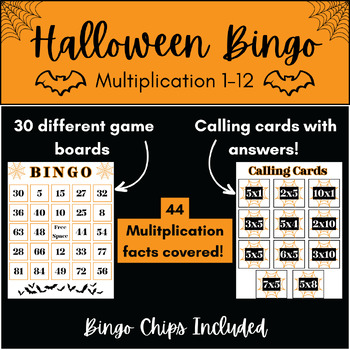Halloween Multiplication 1-12 BINGO Game | 30 Different Game Boards!
MrsPalmerTeaches
34 Followers
Grade Levels
2nd - 4th, Homeschool
Subjects
Resource Type
Standards
CCSS3.NBT.A.3
CCSS3.OA.A.1
CCSS3.OA.B.5
CCSS3.OA.C.7
CCSS4.OA.A.1
Formats Included
- PDF
Pages
40 pages
MrsPalmerTeaches
34 Followers
Also included in
- Elevate your Holiday math festivities with this engaging and educational "Holiday Bingo Game Set" designed for elementary classrooms! This comprehensive resource covers multiplication facts from 1 to 12, adding a dash of excitement to your math lessons in a fun and interactive way.These Bingo gamesPrice $14.70Original Price $21.00Save $6.30
Description
This Halloween-themed multiplication BINGO set is perfect for math facts review, math centers, indoor recess, etc! Includes 44 different facts between 1 & 12.
What’s Included:
-30 different game boards
-2 different bingo chip sheets (1 with cobwebs and 1 with bats)
-4 calling card sheets without answers
-4 calling card sheets with answers
How to Use:
- Each student gets 1 game board and bingo chips (as many as you want them to have).
- The teacher will call out multiplication problems from the calling cards.
- The students place a chip on the number on their board that corresponds with the multiplication problem being called out.
- Wait until someone gets a BINGO!!
*you will need to make copies of the bingo chips as there are only 30 pieces for each design (cobweb and bat) included in the document*
ENJOY with your students and please feel free to leave a review :)
Total Pages
40 pages
Answer Key
N/A
Teaching Duration
Lifelong tool
Report this resource to TPT
Reported resources will be reviewed by our team. Report this resource to let us know if this resource violates TPT’s content guidelines.
Standards
to see state-specific standards (only available in the US).
CCSS3.NBT.A.3
Multiply one-digit whole numbers by multiples of 10 in the range 10–90 (e.g., 9 × 80, 5 × 60) using strategies based on place value and properties of operations.
CCSS3.OA.A.1
Interpret products of whole numbers, e.g., interpret 5 × 7 as the total number of objects in 5 groups of 7 objects each. For example, describe a context in which a total number of objects can be expressed as 5 × 7.
CCSS3.OA.B.5
Apply properties of operations as strategies to multiply and divide. Examples: If 6 × 4 = 24 is known, then 4 × 6 = 24 is also known. (Commutative property of multiplication.) 3 × 5 × 2 can be found by 3 × 5 = 15, then 15 × 2 = 30, or by 5 × 2 = 10, then 3 × 10 = 30. (Associative property of multiplication.) Knowing that 8 × 5 = 40 and 8 × 2 = 16, one can find 8 × 7 as 8 × (5 + 2) = (8 × 5) + (8 × 2) = 40 + 16 = 56. (Distributive property.)
CCSS3.OA.C.7
Fluently multiply and divide within 100, using strategies such as the relationship between multiplication and division (e.g., knowing that 8 × 5 = 40, one knows 40 ÷ 5 = 8) or properties of operations. By the end of Grade 3, know from memory all products of two one-digit numbers.
CCSS4.OA.A.1
Interpret a multiplication equation as a comparison, e.g., interpret 35 = 5 × 7 as a statement that 35 is 5 times as many as 7 and 7 times as many as 5. Represent verbal statements of multiplicative comparisons as multiplication equations.



